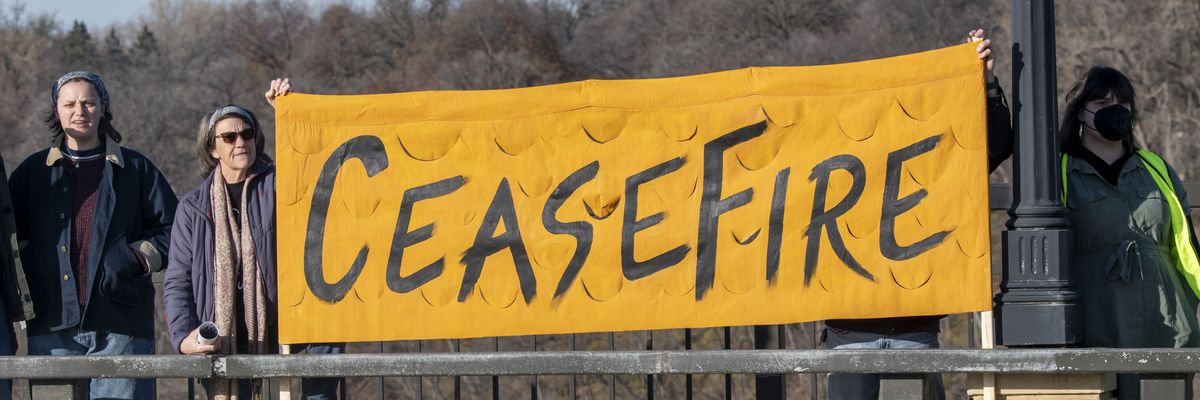Lee Anderson makes antisemitic comment


Original article by RICHARD ESKOW at Common Dreams. I am able to but refrain from quoting this article in full – please be warned that it discusses Aaron Bushnell’s self-immolation in blunt terms.

The head of Save the Children described the Biden Administration’s recent airdrop of food into Gaza airdrop as “theater.” That it is. So is the Vice President’s sudden “demand” for a six-week ceasefire. For that matter, so is the ceasefire itself — if it happens. It’s likely to be characterized by ongoing immiseration and slow death, to be followed by the faster forms of killing.
It’s an American theater of cruelty whose real purpose is to deliver votes for the president, not meals for the starving. It will end as it began: in fire. The question is, what kind of fire and for whom?
The American airdrop consisted of 38,000 “MRE’s,” or “Meals Ready to Eat,” those unwholesome feed bags the US military buys by the millions to feed its underpaid and undervalued soldiers. To call this gesture a publicity stunt is unfair to publicity stunts, which are hollow but rarely lethal. It’s part of a killing strategy of deflection and deception.
More than 2,100,000 people are starving in Gaza; the children are already dying. If divided evenly, every person in Gaza would receive precisely 1.8 percent of each bag pictured above – that is, if they got any of it, which is unlikely amidst all the US-backed chaos. Hunger can’t be cured homeopathically, with microscopic doses.
The average weight of an MRE is 22 ounces. (I looked it up.) That means this airdrop provided roughly one-third of an ounce of food for every man, woman, and child. That’s like a bird hunter scattering breadcrumbs for pigeons before he starts killing them again.
At the going price for MREs (I looked that up, too), the retail cost of the food dropped comes to $617,405. That’s 29 cents for every starving person in Gaza (which is pretty much all of them.) And the military probably got a discount.
Perhaps the cost should be billed to the Biden campaign. Its real purpose is to offset the growing backlash against the administration’s support for mass slaughter, which was quantified in the Michigan primary’s surge of anti-Biden “uncommitted” votes. The president has seemed publicly insensate to the deaths of children, but even his dimming organs of perception can smell unfriendly votes. And whatever he doesn’t catch, his advisors presumably will.
Meanwhile, the president and his party continue to push a bill that would provide $14 billion in military aid to Israel. That’s more than twenty-two thousand times as much as the US spent on this food drop. Roughly $10 billion of that would consist of weapons for the IDF, including “advanced weapons systems” like the ones that are currently destroying apartment buildings, schools, and hospitals.
That cost should be billed to the American conscience.
From the Washington Post: “Critics say airdrops are expensive and ineffective, and argue diplomatic efforts should be focused on opening Gaza’s border crossing to allow aid convoys access.” But that would require confronting Israel, which the Biden Administration has yet to do in any meaningful way.
The United States could send food aid on ships to the Gaza shore with troops through the Rafah Crossing. It could confront Israel with a simple choice: fire on our military, or accept that the policy of mass starvation has come to an end. The fact that it doesn’t means that the dying will continue.
The same inaction gives the lie to Kamala Harris’ belated discovery that “people in Gaza are starving” and her lofty call for “an immediate ceasefire” – which sounds good, except that the administration is absolving Israel of all responsibility for the deaths and for the lack of a ceasefire.
…
Who Was Aaron Bushnell, The Senior U.S. Airman Who Set Himself On … ›
Original article by JULIA CONLEY republished from Common Dreams under Creative Commons (CC BY-NC-ND 3.0).

Australian Prime Minister Anthony Albanese is one of several Western leaders who have provided political and material support of the Israeli government and military over the past five months as their bombardment of Gaza has killed more than 30,000 people, but on Monday he became the first to be referred to the International Criminal Court for being an “accessory to genocide.”
More than 100 lawyers supported the referral under Article 15 of the Rome Statute, arguing that Albanese, a member of the Labor Party, as well as members of his Cabinet and of Parliament, have provided Israel with “rhetorical support in their public statements, their press conferences, their speeches” as well as material assistance, as attorney Sheryn Omeri told ABC‘s “News Breakfast.”
Omeri said the aid Australia has “most particularly” provided since Israel began attacking Gaza has been the export of F-35 fighter jet parts as well as military intelligence through the government’s surveillance work at Joint Defense Facility Pine Gap in Australia’s Northern Territory.
While Albanese has recently called on Israel to respect international law, said Omeri, “it’s been months since the 7th of October, 2023, and between then and now there has been very little in the way of urging restraint on Israel and discouraging what the International Court of Justice found on the 26th of January was a plausible case of genocide.”
The 92-page document compiled by the legal team lays out a number of specific ways Albanese and other Australian officials have acted as an accessory to genocide, including:
“The Rome Statute provides four modes of individual criminal responsibility, two of which are accessorial,” Omeri explained in a statement.
Along with Albanese, U.S. President Joe Biden, British Prime Minister Rishi Sunak, and German Chancellor Olaf Scholz are among the Western leaders who have repeatedly defended Israel’s actions in Gaza—despite the genocidal intent expressed in numerous public statements by Israeli leaders.
Biden was sued in federal court in January for alleged “complicity in the Israeli government’s unfolding genocide.” That case is still making its way through the U.S. appeals process.
Original article by JULIA CONLEY republished from Common Dreams under Creative Commons (CC BY-NC-ND 3.0).

Original article by OLIVIA ROSANE republished from Common Dreams under Creative Commons (CC BY-NC-ND 3.0).

On the eve of Super Tuesday, Minnesota Democratic primary voters are looking to replicate Michigan’s success with their own “uncommitted” campaign to protest President Joe Biden’s support for Israel’s unrelenting assault on the people of Gaza.
The uncommitted vote in Michigan earned more than 100,000 votes—well beyond the campaign’s 10,000-vote goal—and secured at least two delegates for the Democratic National Convention in Chicago in August.
While Minnesota is not a swing state, and therefore may not have the same leverage over the Biden campaign as Michigan, organizers hope they can still send a message and inspire voters in other states.
“We’re hoping that what we do here will just continue to push the wave of uncommitted across the United States,” Amanda Purcell of MN Families for PalestinetoldThe Guardian.
“Voting uncommitted is a chance for Minnesotans to ask the president we fought for to change course, and recommit to all of us.”
Progressive voters hope to use the uncommitted campaigns to persuade Biden to back a permanent cease-fire in Gaza, something that 68% of U.S. voters support, including 80% of Democrats. The campaigns seek to persuade the Biden administration that funding and arming an assault that the International Court of Justice has ruled a plausible genocide is not only immoral, but also a political liability as Biden prepares to face off against former President Donald Trump in November.
“We are organizing our neighbors across the state to tell Joe Biden: permanent cease-fire now!” reads the Vote Uncommitted MN website. “With his approval ratings bottoming-out and a tight race for re-election, we know he is paying close attention to what happens at the ballot box.”
Minnesota is not the only state to pick up the uncommitted call. It is, however, the Super Tuesday state with the most prominent campaign to date. Other Super Tuesday primaries that have an uncommitted or equivalent line are Alabama, Colorado, Iowa, Massachusetts, North Carolina, Tennessee, and American Samoa.
The Colorado Palestine Coalition along with local chapters of the Democratic Socialists of America (DSA), launched a “Vote Noncommitted Colorado” campaign last Wednesday, though more than 762,000 people have already returned their ballots by mail.
“We figured if there’s a way to make some waves and let our discontent be known, we might as well,” organizer Grace Thorvilson toldAxios Denver.
However, organizers in Minnesota say an uncommitted campaign is primed to make an impact in the state because of its history of progressive, democratic engagement and its large Muslim and immigrant population.
“We vote in Minnesota. Number one in the country for turnout,” Abandon Biden campaign in Minnesota co-chair Jaylani Hussein told The Guardian. “And when it comes to minorities and immigrants, we also have historically high, record turnout.”
Campaigners have scrambled to get the word out in the wake of Michigan’s success.
“Y’all Michigan had three weeks. Minnesota now has four and a half days,” organizer Asma Mohammed said on a conference call last week reported by Minnesota Public Radio.
The campaign has received backing from local politicians, including St. Paul City Council President Mitra Jalali and Minneapolis City Council President Aisha Chughtai.
“When you elect leaders, you commit to navigating difficult decisions with them while holding them accountable and standing up for your communities,” the pair wrote in an op-ed Monday in Sajan Journal. “Our communities deserve better than the idea that ‘anyone is better than Trump’—we deserve real leadership that invites accountability. Voting uncommitted is a chance for Minnesotans to ask the president we fought for to change course, and recommit to all of us.”
Some members of the coalition, such as the Abandon Biden movement, want to ensure that Biden does not win the general election in order to impose consequences for his position on Gaza. Others, however, see the primaries as a chance to pressure Biden to reverse course before the general in order to strengthen his position against Trump.
“I’m hoping that President Biden listens, because I don’t want to have to organize my community out of becoming Republicans or just sitting at home,” Mohammed said. “And it’s not just my community.”
Abou Amara, who has previously worked on campaigns for the Minnesota Democratic-Farmer-Labor Party—the state’s Democratic Party affiliate—said that the primary was exactly the right time to put intra-party pressure on candidates.
“The Democratic primaries and the Republican primaries are the moment to exercise political power and to have your voice heard,” Amara told Minnesota Now. “And you’re seeing the Biden administration continue to respond, to say I have to listen to various aspects of my coalition.”
On Sunday, for example, Vice President Kamala Harris gave a speech in Selma in which she called for an immediate cease-fire and said Israel was not doing enough to stop a “humanitarian catastrophe” in Gaza. While Harris only backed a temporary, six-week cease-fire to facilitate a hostage exchange, her rhetoric reflects growing pressure on the party.
AJ+ media critic Sana Saeed said on social media that it was a “blatant attempt to put Harris as sober to Biden’s zeal in the wake of Michigan and polls showing his unpopularity.”
“They know they are in trouble,” she added, “so this is pure PR bait, and it seems some people are falling for it.”
Organizers of the Uncommitted MN campaign hope the pressure will keep up beyond Super Tuesday. Already the United Food and Commercial Workers Local 3000, the largest union in Washington State, has endorsed the uncommitted campaign in that state’s primary on March 12. Efforts are also underway in states including Wisconsin, Arizona, and Pennsylvania.
“This is a national movement,” Mohammed told The Guardian. “It doesn’t stop with Michigan. It doesn’t stop with Minnesota. All of us have to be all in to get the attention of the president.”
Original article by OLIVIA ROSANE republished from Common Dreams under Creative Commons (CC BY-NC-ND 3.0).
Original article by Phoebe Cooke republished from DeSmog
Series: DRAX: THE UK’S ‘CARBON NEUTRAL’ BIOMASS POWER PLANT

Plans by biomass giant Drax to manufacture wood pellets sourced from Californian forests will endanger natural habitats and increase toxic air pollution for rural communities, campaigners warn.
The British energy company has partnered with Golden State Natural Resources, a government-linked nonprofit which plans to build two industrial plants in rural California counties that would produce one million tonnes of compressed wood fiber pellets a year.
One plant would be in Tuolumne County in the foothills of the Sierra Nevada Mountains, and the other in Lassen County in the state’s far northeast. From there, pellets would be shipped by rail to the city of Stockton, exported internationally, and burnt as biomass fuel to create electricity.
At its board meeting last Wednesday, Golden State Natural Resources ratified a Memorandum of Understanding (MOU) with Drax.
The agreement comes as a BBC investigation revealed that Drax was burning rare forest wood in the Canadian province of British Columbia.
BBC Panorama found that in 2023 the company took more than 40,000 tonnes of wood from so-called “old-growth” forests in B.C. Following the investigation, the company issued a statement expressing confidence that its “biomass is sustainable and legally harvested.”
Drax already operates 18 wood pellet plants across the U.S. and Canada, but the MOU finalized on February 28 is the most concrete indication yet of Drax’s ambition to expand into California, a state with 33 million acres of forest.
The wood pellets Drax produces are treated as “carbon neutral” under international accounting rules, based on an assumption that new-growth trees will capture the carbon lost by wood burnt for electricity. But scientists and campaigners have long disputed these claims.
A 2021 study from the European Academies Science Advisory Council concluded that burning wood for energy “is not effective in mitigating climate change and may even increase the risk of dangerous climate change.” A power station operated by Drax in the UK generates 8 percent of the UK’s “renewable” electricity, but is also the single largest emitter of carbon dioxide.
Golden State Natural Resources claims its forest management techniques reduce the risk of wildfires — a claim which has also been disputed by campaigners — and that it maintains “stringent guardrails” to ensure the sourcing of materials for pellets is sustainable. Drax also says its pellets are made from “sustainable biomass” generated from low-grade roundwood, sawmill residues, and forest residues — although several investigations have found instances of the company using primary forest materials.
The plan calls for sourcing wood from areas that encompass eight National Forests, and activists in California have raised concerns that the production of this “renewable” power could endanger vital biodiversity in the forests, home to California’s endangered gray wolves. They are also concerned that the facilities could harm local communities, some of which face high health burdens.
A January 2024 study by the journal Renewable Energy found that thousands of tons of toxic air pollutants, from nitrogen oxide to volatile organic compounds, are emitted in the pellet-making process, especially in the southeastern United States where most pellet plants are located.
Rita Frost, a forests advocate from environmental nonprofit Natural Resources Defense Council (NRDC), said the project would “diminish our forests’ ability to contribute to the fight against climate change, increase carbon emissions during a critical juncture when we must be reducing them instead, and compound health harms in vulnerable communities.”
Golden State Natural Resources is a nonprofit co-founded by a state agency and a service organization that represents California’s rural counties. A document on the group’s website describes its purpose as “to build wildfire and forest resilience in the state and spur economic opportunities in rural communities.”
The MOU between Drax and the Californian nonprofit echoes those goals, stating that the companies should “work collaboratively and in good faith” to identify “potential sustainable vegetation management projects on forest land that meet the dual goals of promoting forest resilience and producing sustainable biomass fuel.”
GSNR says its proposed project would source pellet materials from a mixture of native forests undisturbed by human activity, and forests that have been subjected to logging cycles but allowed to regenerate, as well as privately managed timberland.
On its “Frequently Asked Questions” page, GSNR claims that its removal of accumulated fuel will help California’s forests burn “with less frequency and less intensity over the long term.”
A quarter of California — more than 25 million acres — is classified as under very high or extreme fire threat, with over 25 percent of the state’s population living in these high fire-risk areas. The counties where GSNR plans to cite its facilities have small populations but are no strangers to fire; the second-largest fire in state history, which covered nearly one million acres, burned partially in Lassen County.
But the practice of removing trees or thinning forests to reduce fire danger is controversial, and some experts say it can actually increase the severity of fires.
Michelle Connolly, an ecologist and director of Conservation North, says GSNR is justifying its activity by using “scientific-sounding language to make it seem like they know what they’re doing.”
“Logging and road building in any kind of primary forests is associated with increasing fire risk,” she said.
“Fire is the latest Trojan Horse for industry to get into natural forests they otherwise might not get to violate. Pellets originating from primary forest are not sustainable in any way, shape or form.”

Megan Fiske, a wildlife biologist at the Central Sierra Environmental Resource Center and a Tuolumne County resident, also has concerns over the impact of the clearance on forest health and natural habitats.
Each facility would source wood from a 100-mile radius, an area that includes eight National Forests and a major biodiversity hotspot. Dozens of endangered or threatened species take refuge in these zones — including California’s fledgling population of gray wolves, which were threatened with extinction and have only recently returned to the state.
“We need to restore the forest ecosystem and its natural processes,” Fiske told DeSmog.
“Removing the nutrients and other benefits imparted by ‘biomass’ does not restore the forest ecosystem or its natural processes, which provide tremendous ecosystem services.”
The number of industrial wood pellet mills has risen rapidly in the U.S. and Canada to meet a rising demand for biomass-fuelled energy in Europe and Asia.
The two production plants planned for California are located in former timber industrial areas in rural counties, where drought and other extreme weather events associated with rising temperatures from climate change compound existing health inequalities.
Tuolumne County, which is home to part of Yosemite National Park, has a higher-than-average pollution burden, high rates of asthma and cardiovascular disease, and a high poverty rate, according to data in CalEnviroScreen 4.0 Indicator Maps.
Residents in Lassen have similar health outcomes to the state average, but on average die earlier than their neighbors.
The mapping tool CalEnviroScreen shows that the communities living around the port of Stockton, where the pellets will be shipped from, are some of the most disadvantaged in the state, based on factors including poor air quality, low income, and poor health indicators.
Though subject to environmental regulations, the production of pellets can release vast amounts of sawdust and other harmful particulates that impact air quality.
In May 2023, The Guardian reported a U.S. plant supplying wood pellets to Drax had violated air pollution limits in Mississippi. A September 2022 investigation by Unearthed found Drax was driving “environmental racism” after air pollution claims in the southeastern United States. Drax paid out $3.2 million to settle.
“These are not the kinds of jobs that our rural communities deserve. They are low wage positions and extremely dangerous working conditions.” – Nick Joslin
Nick Joslin, forest and watershed watch program manager at the Mount Shasta Bioregional Ecology Center, resides in Siskiyou County, an area where wood would be sourced and then transported by truck to the pellet mill in the Lassen County town of Nubieber.
“Siting a facility of this size in a small town is completely irresponsible,” he said.
“There are no services and no housing. Where would any newly employed people live? Where would they receive basic services or send their kids to school? The facility would run 24 hours a day with noise, lighting, dust, and noxious fumes.”
Golden State Natural Resources has also said the project will create 128 full-time jobs once both sites are operational, but Joslin is skeptical that these will provide the economic opportunities the county needs.
“These are not the kinds of jobs that our rural communities deserve. They are low wage positions and extremely dangerous working conditions,” Joslin added.
Fiske, of Tuolumne County, says the counties of the Sierra Nevada once exploited by the gold, timber, and water industries are now being hit by the latest cycle of commercial-scale resource extraction.
“We must keep the rivers clean and healthy, we must keep the forests from emitting too much wildfire smoke. All while the logging trucks and water trucks deteriorate our local roads and slow and impede traffic. All while employees are imported from elsewhere to take the temporary, barely living wage jobs.”
As a “renewable” energy provider, Drax has benefited from billions of pounds in subsidies from the UK government. The thinktank Ember has estimated it will have collected more than £11 billion between 2012 and 2027, when the support runs out.
The company is now looking to gain an estimated £31.7 billion in additional subsidies for the controversial technology of bioenergy, carbon capture and storage (BECCS) — where emissions from burning organic matter are captured and buried underground.
Advocates promote this as a “carbon negative” climate solution, but experts and campaigners have argued that BECCS is technically unproven, and that the practice poses risks for biodiversity, land, and food security.
The UK government this year approved two new carbon capture units at Drax’s Yorkshire power station, while Drax is looking to roll out the technology to other countries — among them the U.S.
DeSmog reported in 2022 that Drax had lobbied California’s government to build a BECCS plant in the state, describing it as an “ideal location.” A UK government consultation on Drax’s future subsidies closed on Thursday (February 29), with a decision expected in April.
Campaigners say both the burning of biomass, and the attempted capture of its emissions, is deeply flawed.
“For California, there’s no time to waste on false solutions like this,” Rita Frost of NRDC told DeSmog.
“Any climate plan that relies on BECCS development with Drax is extremely high risk. Funds should instead be directed to wind and solar energy, which are not only low-cost and low-risk, but actually help fight the climate crisis.”
Drax and Golden State Natural Resources did not respond by publication time to specific questions submitted.
Original article by Phoebe Cooke republished from DeSmog